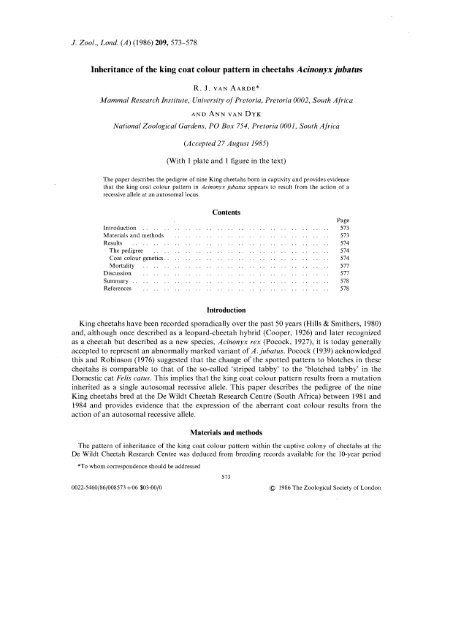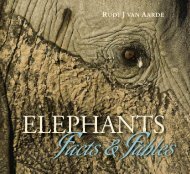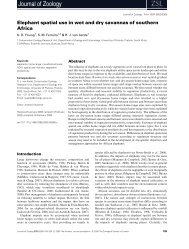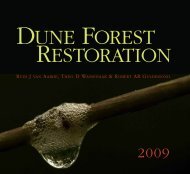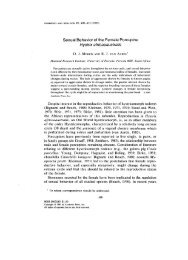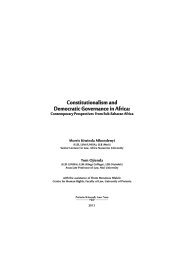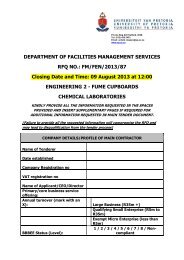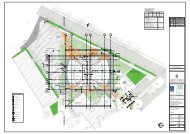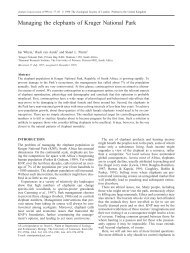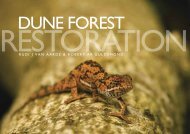Inheritance of the king coat colour pattern in cheetahs ... - CERU
Inheritance of the king coat colour pattern in cheetahs ... - CERU
Inheritance of the king coat colour pattern in cheetahs ... - CERU
You also want an ePaper? Increase the reach of your titles
YUMPU automatically turns print PDFs into web optimized ePapers that Google loves.
1. Zool., Lond. (A) (1986) 209, 573-578<br />
<strong>Inheritance</strong> <strong>of</strong> <strong>the</strong> <strong>k<strong>in</strong>g</strong> <strong>coat</strong> <strong>colour</strong> <strong>pattern</strong> <strong>in</strong> <strong>cheetahs</strong> Ac<strong>in</strong>onyx jubatus<br />
R. 1. VAN AARDE*<br />
Mammal Research Institute, University <strong>of</strong> Pretoria, Pretoria 0002, South Africa<br />
AND ANN VAN DYK<br />
National Zoological Gardens, PO Box 754, Pretoria 0001, South Africa<br />
(Accepted 27 August 1985)<br />
(With 1 plate and 1 figure <strong>in</strong> <strong>the</strong> text)<br />
The paper describes <strong>the</strong> pedigree <strong>of</strong> n<strong>in</strong>e K<strong>in</strong>g <strong>cheetahs</strong> born <strong>in</strong> captivity and provides evidence<br />
that <strong>the</strong> <strong>k<strong>in</strong>g</strong> <strong>coat</strong> <strong>colour</strong> <strong>pattern</strong> <strong>in</strong> Ac<strong>in</strong>onyx jubatus appears to result from <strong>the</strong> action <strong>of</strong> a<br />
recessive allele at an autosomal locus.<br />
Contents<br />
Page<br />
Introduction 573<br />
Materials and methods 573<br />
Results ....... . 574<br />
The pedigree 574<br />
Coat <strong>colour</strong> genetics .. 574<br />
Mortality 577<br />
Discussion 577<br />
Summary .. .. . . . . 578<br />
References 578<br />
Introduction<br />
K<strong>in</strong>g <strong>cheetahs</strong> have been recorded sporadically over <strong>the</strong> past 50 years (Hills & Smi<strong>the</strong>rs, 1980)<br />
and,.although once described as a leopard-cheetah hybrid (Cooper, 1926) and later recognized<br />
as a chectah but described as a ncw species, Ac<strong>in</strong>onyx rex (Pocock, 1927), it is today generally<br />
accepted to represent an abnormally marked variant <strong>of</strong> A.jubatus. Pocock (1939) acknowledgcd<br />
this and Rob<strong>in</strong>son (1976) suggested that <strong>the</strong> change <strong>of</strong> <strong>the</strong> spotted <strong>pattern</strong> to blotches <strong>in</strong> <strong>the</strong>se<br />
<strong>cheetahs</strong> is comparable to that <strong>of</strong> <strong>the</strong> so-called 'striped tabby' to <strong>the</strong> 'blotched tabby' <strong>in</strong> thc<br />
Domestic cat Felis catus. This implies that thc <strong>k<strong>in</strong>g</strong> <strong>coat</strong> <strong>colour</strong> <strong>pattern</strong> results from a mutation<br />
<strong>in</strong>herited as a s<strong>in</strong>gle autosomal recessive allele. This paper describes <strong>the</strong> pedigree <strong>of</strong> <strong>the</strong> n<strong>in</strong>e<br />
K<strong>in</strong>g <strong>cheetahs</strong> bred at <strong>the</strong> De Wildt Cheetah Research Centre (South Africa) between 1981 and<br />
1984 and provides evidence that <strong>the</strong> expression <strong>of</strong> <strong>the</strong> aberrant <strong>coat</strong> <strong>colour</strong> results from <strong>the</strong><br />
action <strong>of</strong> an autosomal recessive allele.<br />
Materials and methods<br />
The <strong>pattern</strong> <strong>of</strong> <strong>in</strong>heritance <strong>of</strong> <strong>the</strong> <strong>k<strong>in</strong>g</strong> <strong>coat</strong> <strong>colour</strong> pattcrn with<strong>in</strong> <strong>the</strong> captive colony <strong>of</strong> <strong>cheetahs</strong> at <strong>the</strong><br />
De Wildt Cheetah Research Centre was deduced from breed<strong>in</strong>g records available for <strong>the</strong> lO-year period<br />
*To whom correspondence should be addressed<br />
573<br />
0022-5460/86/008573 +06 $0300/0 © 1986 Thc Zoological Society <strong>of</strong> London
574 R.1. VAN AARDE AND ANN VAN DYK<br />
from 1975 to 1984. Husbandry and breed<strong>in</strong>g <strong>of</strong><strong>cheetahs</strong> at <strong>the</strong> Centre has been described elsewhere (Brand,<br />
1980). The breed<strong>in</strong>g system, where females were isolated from males except for mat<strong>in</strong>g purposes, provided<br />
<strong>the</strong> opportunity to select artificially breed<strong>in</strong>g pairs. Suspected pregnant females were each housed separately<br />
<strong>in</strong> maternity enclosures after mat<strong>in</strong>g with a selected male. Males did not rega<strong>in</strong> access to <strong>the</strong>se females<br />
until <strong>the</strong> onset <strong>of</strong> <strong>the</strong> Collow<strong>in</strong>g mat<strong>in</strong>g season, thus ensur<strong>in</strong>g <strong>the</strong> planned parentage <strong>of</strong> litters.<br />
Shelters with<strong>in</strong> each maternity enclosure were <strong>in</strong>spected daily for <strong>the</strong> presence <strong>of</strong> cubs or aborted foetuses,<br />
or any o<strong>the</strong>r signs oCparturition, and <strong>the</strong> dates, sex composition and <strong>coat</strong> <strong>colour</strong>s <strong>of</strong> all litters were recorded<br />
where possible. Cheetahs with a spotted <strong>coat</strong> <strong>colour</strong> <strong>pattern</strong> will, for <strong>the</strong> purpose <strong>of</strong> this discussion, be<br />
referred to as <strong>the</strong> 'wild type' and those with a blotched <strong>coat</strong> <strong>colour</strong> <strong>pattern</strong>, as '<strong>k<strong>in</strong>g</strong>s'.<br />
Results<br />
The pedigree<br />
The coa t <strong>colour</strong> <strong>pattern</strong>s <strong>of</strong> <strong>the</strong> n<strong>in</strong>e K<strong>in</strong>g <strong>cheetahs</strong> are very different to those <strong>of</strong> <strong>the</strong> wild type<br />
(Plate I), but similar to those <strong>of</strong> <strong>the</strong> study sk<strong>in</strong>s <strong>of</strong> A. rex, as described and illustrated by Hills &<br />
Smi<strong>the</strong>rs (1980). These were all characterized by <strong>the</strong> partial replacement <strong>of</strong> <strong>the</strong> normal spots by<br />
broad bands form<strong>in</strong>g whorls and spiral arrangements similar to tbose occurr<strong>in</strong>g <strong>in</strong> <strong>the</strong> blotched<br />
tabby Domestic cal.<br />
The pedigrees <strong>of</strong> <strong>the</strong> n<strong>in</strong>e K<strong>in</strong>g cbeetahs produced are illustrated <strong>in</strong> Fig. 1. The three wild type<br />
mo<strong>the</strong>rs <strong>in</strong>volved orig<strong>in</strong>ated from two consecutive litters produced by a wild type male (Chris)<br />
and female (Lady) caught <strong>in</strong> SWAjNamibia and <strong>the</strong> nor<strong>the</strong>rn TransvaaL South Africa, respectively.<br />
One <strong>of</strong> <strong>the</strong> three wild type males (Frik), which sired K<strong>in</strong>g <strong>cheetahs</strong>, was similarly captured<br />
as a free-rang<strong>in</strong>g animal <strong>in</strong> <strong>the</strong> nor<strong>the</strong>rn TransvaaL The o<strong>the</strong>r two males (Ben and M35) were<br />
born follow<strong>in</strong>g mat<strong>in</strong>gs between Prik and a wild type female (Gill), caught <strong>in</strong> <strong>the</strong> eastern<br />
TransvaaL<br />
Mat<strong>in</strong>gs between <strong>the</strong> wild type male Frik and two <strong>of</strong> <strong>the</strong> wild type daughters (Jean and Jumper)<br />
resulted <strong>in</strong> <strong>the</strong> birth <strong>of</strong> two K<strong>in</strong>g <strong>cheetahs</strong>. All <strong>the</strong> o<strong>the</strong>r K<strong>in</strong>g <strong>cheetahs</strong> were conceived<br />
by mat<strong>in</strong>g his male wild type progeny (Ben and M35) with <strong>the</strong> wild type females, Jean and F20<br />
(pig. 1).<br />
A mat<strong>in</strong>g between Prik and Lady (wild type, wild caught mo<strong>the</strong>r <strong>of</strong> three sibl<strong>in</strong>gs which <strong>in</strong><br />
turn produced K<strong>in</strong>g <strong>cheetahs</strong>) did not produce a K<strong>in</strong>g. This suggests that Lady was not a carrier<br />
<strong>of</strong> tbe '<strong>k<strong>in</strong>g</strong>' trait and <strong>in</strong>dicates that her daughters <strong>in</strong>herited <strong>the</strong> cbaracter from <strong>the</strong> fatber, Cbris.<br />
It sbould, however, be noted that <strong>the</strong>se data do not preclude Lady from be<strong>in</strong>g a carrier.<br />
Coat <strong>colour</strong> genetics<br />
The bypo<strong>the</strong>sis that <strong>the</strong> '<strong>k<strong>in</strong>g</strong>' pbenotype results from a s<strong>in</strong>gle autosomal recessive mutation is<br />
supported by <strong>the</strong> fact tbat K<strong>in</strong>g cbeetabs <strong>of</strong> both sexes were produced by wild type parents and<br />
<strong>of</strong>fspr<strong>in</strong>g <strong>of</strong> tbese wild type parents. If <strong>the</strong> '<strong>k<strong>in</strong>g</strong>' phenotype results from a mutation <strong>of</strong> a gene<br />
locus, homologous to <strong>the</strong> tabby locus <strong>in</strong> <strong>the</strong> Domestic cat, it is expected that <strong>the</strong> <strong>pattern</strong> <strong>of</strong><br />
<strong>in</strong>heritance would be similar to tbat <strong>of</strong> <strong>the</strong> blotched tabby <strong>pattern</strong> and thus typical <strong>of</strong> a s<strong>in</strong>gle<br />
autosomal recessive gene.<br />
In designat<strong>in</strong>g <strong>the</strong> '<strong>k<strong>in</strong>g</strong>' character as tb and its dom<strong>in</strong>ant allele as t + , it follows that all K<strong>in</strong>g<br />
<strong>cheetahs</strong> must be <strong>of</strong> <strong>the</strong> genotype tbt b and wild types ei<strong>the</strong>r /+ /" or t+ t+. K<strong>in</strong>g <strong>cheetahs</strong> will<br />
only be produced by t+tb or {btb parents and wild type carriers by mat<strong>in</strong>gs between /+/+ and<br />
t+ tb or t+ tb and t+ tb or t+ tb and tbtb parents.
INHERITANCE OF KING COAT COLOUR<br />
575<br />
PLATE I. The first K<strong>in</strong>g cheetah produced at <strong>the</strong> Dc Wildt Cheetah Research Centre.<br />
The ratio <strong>of</strong> K<strong>in</strong>g <strong>cheetahs</strong> to wild type progeny result<strong>in</strong>g from rna t<strong>in</strong>gs between <strong>the</strong> different<br />
genotypes is <strong>in</strong> accordance (x 2 = O· 32) with <strong>the</strong> hypo<strong>the</strong>sis <strong>of</strong> a s<strong>in</strong>gle autosomal gene, where<br />
<strong>the</strong> mutant allele '<strong>k<strong>in</strong>g</strong>' is recessive to <strong>the</strong> wild type allele (Table I).<br />
S<strong>in</strong>ce <strong>the</strong> grandparcnts <strong>of</strong> <strong>the</strong> K<strong>in</strong>g <strong>cheetahs</strong> failed to produce <strong>the</strong> <strong>k<strong>in</strong>g</strong> <strong>coat</strong> <strong>colour</strong>, we suggest<br />
that each <strong>of</strong> <strong>the</strong>se orig<strong>in</strong>al mat<strong>in</strong>gs <strong>in</strong>volved a t+ t+ and t + tb <strong>in</strong>dividual. Early deaths precluded<br />
test-cross<strong>in</strong>g to prove this, but at least one <strong>of</strong> <strong>the</strong>se males (Frik), was, through his production <strong>of</strong><br />
K<strong>in</strong>g <strong>cheetahs</strong>, positively identified as heterozygous for this character. At least two <strong>of</strong> <strong>the</strong> 12<br />
progeny <strong>in</strong> three litters result<strong>in</strong>g from this male and <strong>the</strong> wild type female (Gill) were similarly<br />
proved to be heterozygous (Fig. 1). Fur<strong>the</strong>rmore, three (Jean, Jumper and F20) <strong>of</strong> <strong>the</strong> 18 wild<br />
type progeny <strong>of</strong> <strong>the</strong> wild type grandparents (Chris and Lady) have been provisionally identified<br />
as heterozygous carriers <strong>of</strong> <strong>the</strong> '<strong>k<strong>in</strong>g</strong>' character.
576 R. 1. VAN AARDE AND ANN VAN DYK<br />
M F M F<br />
Chris- A- - Lady Frik-- A- --Gill<br />
1976 [<br />
1976<br />
F M M M F F F M <br />
Jean<br />
Ben <br />
F<br />
Jumper<br />
~ 1977 1977<br />
F20 F M M M M M M M M35 F F<br />
~. A<br />
1981<br />
I i I i I<br />
M M M M M<br />
K<strong>in</strong>g<br />
1981<br />
i I i<br />
F F M<br />
K<strong>in</strong>g<br />
A<br />
A<br />
1983<br />
i i I i I<br />
U U U U U<br />
K<strong>in</strong>g K<strong>in</strong>g<br />
, /<br />
v<br />
Died as <strong>in</strong>fants<br />
A<br />
J ":~<br />
11983<br />
F F F M 1984<br />
K<strong>in</strong>g i i i<br />
1983 ~ M U U U<br />
Died as <strong>in</strong>fants<br />
K<strong>in</strong>g<br />
U U U U<br />
1984 '------v--------./<br />
K<strong>in</strong>g K<strong>in</strong>g<br />
U<br />
~------vr-----~<br />
K<strong>in</strong>g ----+ Died as <strong>in</strong>fants<br />
Died as <strong>in</strong>fants<br />
FIG. 1. Pedigree <strong>of</strong> <strong>the</strong> n<strong>in</strong>e K<strong>in</strong>g <strong>cheetahs</strong> born at <strong>the</strong> De Wildt Cheetah Research Centre between 1981 and 1984<br />
(M = males; F = females; U = sex unknown).<br />
I
INHERITANCE OF KING COAT COLOUR<br />
577<br />
T ABLE I<br />
Observed and expected numher <strong>of</strong> K<strong>in</strong>g and wild tl'pe progeny from mat<strong>in</strong>gs<br />
hetween different presumed genotypes. The calculation <strong>of</strong> <strong>the</strong> expected numbers<br />
were based on <strong>the</strong> hypo<strong>the</strong>sis that <strong>the</strong> K<strong>in</strong>g phenotype results from a<br />
s<strong>in</strong>gle autosomal recessive mutant<br />
Number Observed Expected<br />
<strong>of</strong> TM~ ~<br />
Mat<strong>in</strong>g litters progeny K<strong>in</strong>g Wild type K<strong>in</strong>g Wild type value<br />
8 26 9 17 6·5 19·5 0·32<br />
TABLE II<br />
The relationship hetween phenotype and survival <strong>of</strong><br />
cubs produced dur<strong>in</strong>g 1981, 1983 and 1984 at <strong>the</strong><br />
De Wildt Cheetah Research Centre<br />
Number <strong>of</strong> cubs<br />
Phenotypes surviv<strong>in</strong>g dy<strong>in</strong>g<br />
K<strong>in</strong>g 3 6<br />
Wild type 23 49<br />
Total 26 55<br />
Mortality<br />
The <strong>in</strong>formation <strong>in</strong> Fig. 1 <strong>in</strong>dicates a high <strong>in</strong>fant mortality amongst captive <strong>cheetahs</strong>, K<strong>in</strong>gs<br />
also succumb<strong>in</strong>g with only three surviv<strong>in</strong>g to adulthood. Two <strong>of</strong> <strong>the</strong>m had to be hand-raised<br />
due to abandonment by <strong>the</strong> mo<strong>the</strong>r. However, <strong>the</strong> proportion <strong>of</strong> K<strong>in</strong>g <strong>cheetahs</strong> dy<strong>in</strong>g as <strong>in</strong>fants<br />
did not differ significantly from <strong>the</strong> proportion <strong>of</strong> wild type <strong>in</strong>dividuals that died (x 2 = 0·01;<br />
Table II).<br />
Discussion<br />
The breed<strong>in</strong>g <strong>of</strong> K<strong>in</strong>g <strong>cheetahs</strong> from a captive group <strong>of</strong> wild type <strong>cheetahs</strong> removes all doubts<br />
regard<strong>in</strong>g <strong>the</strong> specific status <strong>of</strong> A. rex and confirms earlier suggestions (Pocock, 1939; Rob<strong>in</strong>son,<br />
1976; Hills & Smi<strong>the</strong>rs, 1980) that <strong>the</strong> K<strong>in</strong>g cheetah merely represents a <strong>colour</strong> variant <strong>of</strong><br />
A.jubatus. Fur<strong>the</strong>rmore, our <strong>in</strong>formation provides evidence that <strong>the</strong> <strong>k<strong>in</strong>g</strong> trait is <strong>in</strong>herited as an<br />
autosomal recessive allele, which probably arose from a mutation at <strong>the</strong> tabby locus. The concept<br />
<strong>of</strong> gene homology is generally accepted today (Rob<strong>in</strong>son, 1970, 1976). Most felids have a<br />
characteristic and consistent striped, spotted or rosetted <strong>pattern</strong> <strong>of</strong> dark pigment overlaid on an<br />
agouti background (Rob<strong>in</strong>son, 1976). Based on <strong>in</strong>formation available from Domestic cat breed<strong>in</strong>g,<br />
this basic <strong>pattern</strong> appears to be controlled by a s<strong>in</strong>gle locus, designated <strong>the</strong> tabby locus<br />
(Rob<strong>in</strong>son, 1976).<br />
The apparent similarities between <strong>the</strong> blotched tabby and <strong>k<strong>in</strong>g</strong> phenotypes and <strong>pattern</strong>s <strong>of</strong><br />
<strong>in</strong>heritance may be <strong>in</strong>terpreted as suggest<strong>in</strong>g homology and support <strong>the</strong> hypo<strong>the</strong>sis that <strong>the</strong> K<strong>in</strong>g<br />
cheetah represents a <strong>colour</strong> variant result<strong>in</strong>g from a mutation at <strong>the</strong> tabby locus.
578 R. J. VAN AARDE AND AN N VAN DYK<br />
Death <strong>of</strong> one <strong>of</strong> <strong>the</strong> parents and all <strong>the</strong> grandparents <strong>of</strong> <strong>the</strong> K<strong>in</strong>g <strong>cheetahs</strong>, <strong>the</strong> present <strong>in</strong>fertile<br />
status <strong>of</strong> <strong>the</strong> surviv<strong>in</strong>g male K<strong>in</strong>g cheetah, immaturity and a high rate <strong>of</strong> <strong>in</strong>fant mortality, are<br />
still preclud<strong>in</strong>g a programme <strong>of</strong> test-cross<strong>in</strong>g to prove fully that <strong>the</strong> <strong>k<strong>in</strong>g</strong> character is <strong>in</strong>herited<br />
as a recessive mutant. The future breed<strong>in</strong>g programme will be adapted and orientated towards<br />
this end.<br />
K<strong>in</strong>g <strong>cheetahs</strong> have been collected and observed <strong>in</strong> a restricted area <strong>in</strong> eastern and sou<strong>the</strong>astern<br />
Zimbabwe, <strong>the</strong> north-eastern Transvaal and eastern Botswana (Hill & Smi<strong>the</strong>rs, 1980).<br />
It is thus surpris<strong>in</strong>g that <strong>the</strong> grandfa<strong>the</strong>r (Chris) <strong>of</strong> <strong>the</strong> K<strong>in</strong>g <strong>cheetahs</strong> orig<strong>in</strong>ated from SW AI<br />
Namibia. We, however, have no reason to th<strong>in</strong>k that <strong>the</strong> SWA/Namibia cheetah population is<br />
isolated from o<strong>the</strong>r populations, imply<strong>in</strong>g that <strong>the</strong> observed mutation is not restricted to a<br />
specific area.<br />
Summary<br />
The fortuitous breed<strong>in</strong>g <strong>of</strong> K<strong>in</strong>g <strong>cheetahs</strong> at <strong>the</strong> De Wildt Cheetah Research Centre gives<br />
conclusive evidence that Ac<strong>in</strong>onyx rex simply represents an unusual <strong>colour</strong> variant <strong>of</strong> Ac<strong>in</strong>onyx<br />
jubatus. Consistency <strong>in</strong> <strong>the</strong> <strong>coat</strong> <strong>colour</strong> <strong>pattern</strong> <strong>of</strong> n<strong>in</strong>e K<strong>in</strong>g <strong>cheetahs</strong> born at <strong>the</strong> Centre, and<br />
<strong>the</strong> <strong>pattern</strong> <strong>of</strong> <strong>in</strong>heritance <strong>the</strong>re<strong>of</strong>, suggests that it is controlled by a recessive allele at a s<strong>in</strong>gle<br />
autosomal locus. The typical change <strong>of</strong> <strong>the</strong> spotted <strong>pattern</strong> to blotches is probably homologous<br />
to a mutation at <strong>the</strong> tabby locus <strong>of</strong> <strong>the</strong> Domestic cat.<br />
Dr T. J. Rob<strong>in</strong>son commented on <strong>the</strong> breed<strong>in</strong>g programme and we would like to thank him and Pr<strong>of</strong>.<br />
J. D. Sk<strong>in</strong>ner for critically read<strong>in</strong>g <strong>the</strong> manuscript. Dr D. G. A. Meltzer assisted <strong>in</strong> all aspects <strong>of</strong> <strong>the</strong><br />
breed<strong>in</strong>g programme and Mrs E. Humpel typed <strong>the</strong> manuscript.<br />
REFERENCES<br />
Brand, D. J. (1980). Captive propagation at <strong>the</strong> National Zoological Gardens <strong>of</strong> South Africa, Pretoria. Int. Zoo. Yb.<br />
20: 107 112.<br />
~'ooper, A. L. (1926). A curious sk<strong>in</strong>. Field 147: 690.<br />
Hills, D. M. & Smi<strong>the</strong>rs, R. H. N. (1980). The '<strong>k<strong>in</strong>g</strong> cheetah': a historical review. Arnoldia Rhodesia 9: 1-23.<br />
Pocock, R. 1. (1927). Description <strong>of</strong> a new species <strong>of</strong> Cheetah (Acillonyx). Proc. zool. Soc. Lond. 1927: 245252.<br />
Pocock, R. 1. (1939). The fauna <strong>of</strong> British India. Mammalia 1. Primates and Carnivora (<strong>in</strong> part). London: Taylor &<br />
Francis.<br />
Rob<strong>in</strong>son, R. (1970). Homologous mutants <strong>in</strong> mammalian <strong>coat</strong> <strong>colour</strong> variation. Symp. zool. Soc. Lond. No. 26:<br />
251-269.<br />
Rob<strong>in</strong>son, R. (1976). Homologous genetic variation <strong>in</strong> <strong>the</strong> Felidae. Genetica 46: 1···31.


